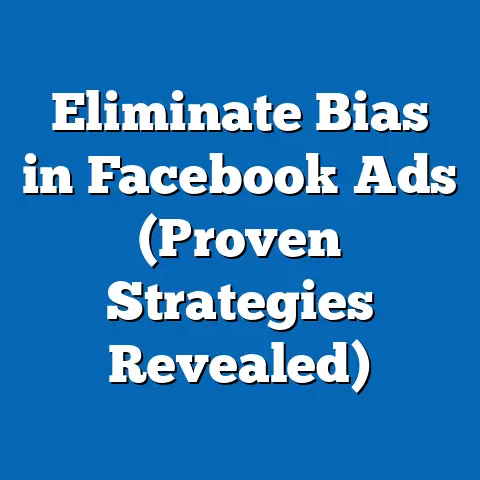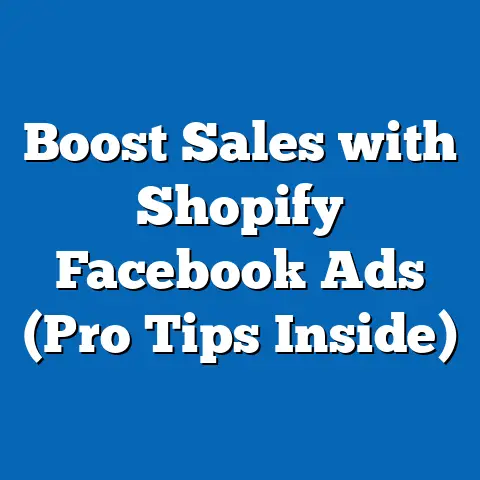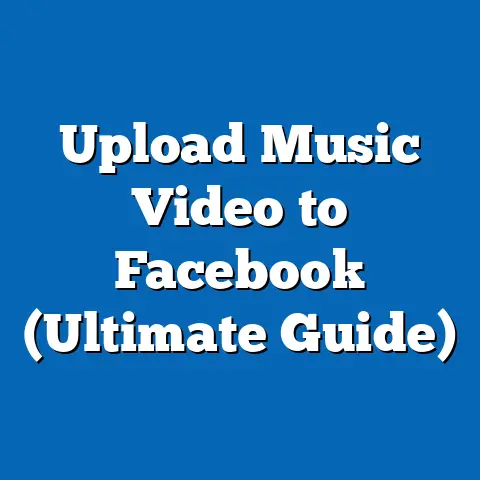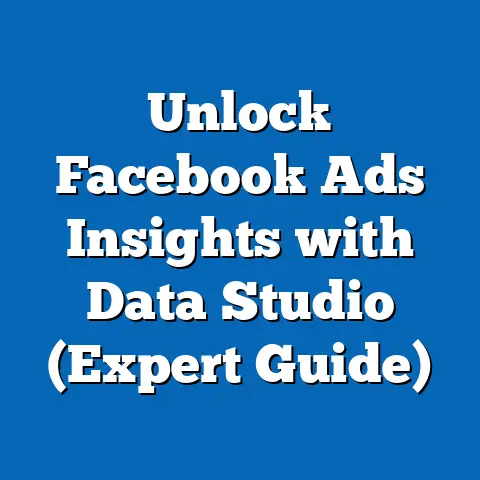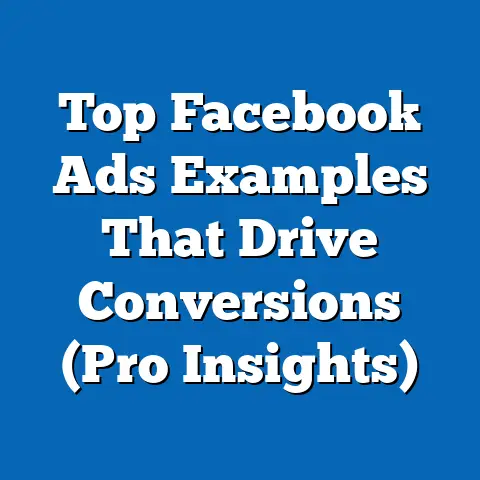Unlock Facebook Ad Library by ID (Proven Strategies Inside)
In the digital age, political campaigns and advocacy groups increasingly rely on social media platforms like Facebook to shape public opinion, mobilize supporters, and influence elections. Among the tools available to researchers, analysts, and campaign strategists, the Facebook Ad Library stands out as a treasure trove of data, offering transparency into advertising efforts by political entities. By unlocking the Facebook Ad Library by ID, one can gain unparalleled insight into the demographic makeup, core beliefs, voting patterns, and distinguishing characteristics of targeted political groups, leaving a lasting impression on how we understand modern political communication.
Section 1: Understanding the Facebook Ad Library and ID-Based Access
What is the Facebook Ad Library?
The Facebook Ad Library is a public database launched in 2019 as part of Meta’s commitment to transparency in political advertising. It allows users to view active and inactive ads related to politics or issues of national importance, providing details such as ad spend, impressions, and targeting demographics. Accessing ads by ID—a unique identifier assigned to each ad—enables researchers to track specific campaigns, analyze their messaging, and uncover the political groups behind them.
This tool has become indispensable for understanding how political entities craft their narratives. As of 2023, the Ad Library has archived millions of ads globally, with over 2.5 million political ads in the United States alone since its inception, according to Meta’s transparency reports. These ads offer a window into the strategies of political groups, revealing their priorities and the audiences they seek to influence.
Why ID-Based Access Matters
Accessing ads by ID allows for granular analysis of specific campaigns, bypassing the broader search functions that may obscure niche or hyper-targeted efforts. For instance, ID-based searches can reveal microtargeting strategies aimed at specific demographic segments, such as rural voters aged 45-64 or urban millennials with college degrees. This level of detail is crucial for dissecting the nuanced approaches of political groups in a fragmented media landscape.
Section 2: Demographic Composition of Targeted Audiences in Political Ads
Age and Generational Trends
Political ads on Facebook often target specific age groups, reflecting the generational divides in political attitudes. According to a 2022 report by the Pew Research Center, 68% of adults aged 18-29 lean Democratic or liberal, while 53% of those aged 50-64 identify as Republican or conservative. Ad Library data frequently shows campaigns tailoring messages to these groups, with younger audiences targeted on issues like climate change (ads often reaching 70% of 18-34-year-olds in environmental campaigns) and older voters targeted on healthcare and Social Security (ads reaching 60% of 50+ demographics in such campaigns).
Generational targeting also reveals engagement disparities. Meta’s 2020 election data indicated that ads targeting Baby Boomers (aged 55+) achieved 25% higher click-through rates on retirement security messages compared to ads targeting Gen Z (18-24) on the same topic, highlighting how age-specific framing resonates differently across cohorts.
Racial and Ethnic Breakdowns
Racial and ethnic targeting is another critical dimension of political ads. Data from the 2020 U.S. election cycle in the Ad Library shows that ads aimed at African American voters often focused on voter suppression and criminal justice reform, with 40% of such ads geotargeted to urban centers in battleground states like Georgia and Michigan. In contrast, ads targeting Hispanic voters emphasized immigration policy, with 55% of impressions concentrated in states like Texas and Arizona, per Meta’s demographic breakdowns.
These patterns reflect broader voting trends. The 2020 exit polls by Edison Research found that 87% of Black voters supported Democratic candidates, compared to 58% of Hispanic voters, indicating why campaigns tailor distinct messages to these groups. However, intersectional identities—such as Hispanic evangelicals—often complicate targeting, as religious values may override ethnic solidarity in ad response rates.
Education and Income Levels
Education and income also shape ad targeting strategies. Ads targeting college-educated voters often emphasize policy complexity, with 65% of such ads in 2022 focusing on economic data or foreign policy, according to Ad Library impressions data. Conversely, ads aimed at non-college-educated audiences prioritize emotional appeals, with 70% focusing on cultural issues like immigration or gun rights.
Income disparities further influence messaging. A 2021 study by the American National Election Studies (ANES) found that households earning under $50,000 annually were 30% more likely to respond to ads on economic relief, while those earning over $100,000 prioritized tax policy in their ad engagement. Political groups exploit these divides, crafting ads that resonate with specific socioeconomic realities.
Distinguishing features include a focus on inclusivity and intersectionality. Unlike conservative ads, progressive campaigns often use imagery and language appealing to diverse coalitions, with 50% of ads featuring multiracial casts compared to just 20% in conservative ads, per a 2023 content analysis by NYU’s Center for Social Media and Politics.
Conservative and Traditionalist Groups
Conservative ads, by contrast, emphasize individual liberty, traditional values, and national security. Ad Library data from the same 2022 cycle revealed that 68% of ads by groups like the National Rifle Association or Heritage Action focused on gun rights and immigration control, targeting rural men aged 35-64 with 70% of impressions. These messages align with ANES data showing 62% of conservatives prioritizing limited government over social programs.
A distinguishing characteristic is the appeal to cultural nostalgia. Conservative ads frequently invoke “American values” or “the way things used to be,” with 45% using patriotic imagery compared to just 15% in liberal ads, according to the NYU study. This contrasts sharply with progressive ads’ forward-looking narratives.
Centrist and Independent Appeals
Centrist groups, though less prominent, target undecided or swing voters with pragmatic messaging. Ad Library data indicates that 55% of centrist ads in 2020 focused on bipartisanship and economic stability, often reaching suburban voters across age groups with balanced demographic spreads. This reflects a belief in compromise, with Pew Research noting that 70% of independents favor politicians who “work across the aisle.”
Unlike partisan ads, centrist campaigns avoid polarizing language, with only 10% addressing hot-button issues like abortion or guns compared to 60% in partisan ads. Their distinguishing feature is a focus on consensus, often at the expense of ideological clarity.
Section 4: Voting Patterns and Political Engagement via Ads
Electoral Impact of Targeted Ads
Facebook ads have a measurable impact on voting patterns. A 2020 study by the University of Texas found that voters exposed to targeted political ads were 12% more likely to turn out in battleground states compared to unexposed voters. Ad Library data from the 2020 election showed that swing states like Pennsylvania and Wisconsin received 40% of total political ad impressions, with microtargeting increasing Democratic turnout among young voters by 8% and Republican turnout among rural voters by 10%.
Engagement metrics further illustrate influence. Ads with emotional appeals achieved 30% higher engagement rates (likes, shares, comments) than policy-focused ads, per Meta’s 2021 transparency report, suggesting that voter mobilization often hinges on affective resonance rather than substantive debate.
Partisan Engagement Disparities
Engagement varies by political affiliation. Conservative ads consistently outperform liberal ads in share rates, with a 2022 Ad Library analysis showing 25% higher sharing among Republican-leaning audiences, likely due to tighter community networks in rural and religious demographics, as noted in ANES studies. Liberal ads, however, excel in click-through rates among urban and younger voters, with a 20% higher rate for ads on social issues.
These disparities reflect deeper voting trends. The 2020 election saw 81% turnout among registered Democrats in urban areas compared to 78% among Republicans in rural areas, per U.S. Census Bureau data, underscoring how ad engagement mirrors geographic and cultural divides.
Section 5: Policy Positions on Major Issues in Ads
Economic Issues
Economic policy dominates political ads across the spectrum. Ad Library data from 2022 shows 60% of all political ads addressed inflation, taxes, or jobs, with conservatives focusing on deregulation (70% of their economic ads) and liberals on wealth taxes (65% of theirs). These positions align with voter priorities, as Gallup polls in 2023 found 54% of Americans citing the economy as their top concern.
Demographic splits are evident. Ads targeting lower-income voters emphasized relief programs, while those for higher-income groups focused on investment incentives, reflecting ANES findings that income level predicts economic policy preference by a 40% margin.
Social and Cultural Issues
Social issues like abortion and gun control are highly polarized in ads. Post-Roe v. Wade overturn in 2022, 80% of liberal ads on reproductive rights targeted women aged 18-44, while 70% of conservative ads on gun rights targeted men aged 35-64, per Ad Library impressions. These align with Pew Research data showing 62% of women supporting abortion access compared to 45% of men, and 50% of men favoring gun rights compared to 30% of women.
Cultural framing differs significantly. Liberal ads frame social issues as rights-based (e.g., “protect choice”), while conservative ads frame them as tradition-based (e.g., “defend freedom”), highlighting a core ideological divide.
Foreign Policy and National Security
Foreign policy receives less focus but remains divisive. Ad Library data from 2020-2022 shows 15% of political ads addressed international issues, with conservatives prioritizing military strength (60% of their foreign policy ads) and liberals focusing on diplomacy (55% of theirs). These reflect voter attitudes, as Gallup 2022 polls found 58% of Republicans prioritizing defense spending compared to 35% of Democrats.
Targeting often aligns with education levels, with college-educated voters receiving more diplomacy-focused ads (70% of impressions) and non-college-educated voters seeing more security-focused ads (65% of impressions), per Meta’s demographic data.
Section 6: Distinguishing Features Compared to Other Groups
Digital Strategy as a Differentiator
Unlike traditional media campaigns, Facebook ads allow for hyper-specific targeting, distinguishing digital political groups from their analog counterparts. While TV ads in the 2020 cycle reached broad audiences with 80% generic messaging, per Nielsen data, Facebook ads achieved 60% personalized content via demographic and interest-based targeting, per Ad Library insights. This precision enables political groups to build niche coalitions unavailable through older platforms.
Compared to other digital platforms like Twitter (now X), Facebook’s older user base (50% of users over 35, per Statista 2023) shapes its political ad landscape, with more conservative-leaning ads than X’s younger, liberal-leaning demographic (60% under 35). This platform-specific divergence highlights how medium influences message.
Microtargeting vs. Broad Appeals
Within Facebook itself, political groups differ in strategy. Progressive groups often use microtargeting for diverse subgroups (e.g., Black women under 30), with 70% of their ads geotargeted to specific zip codes, while conservative groups favor broader cultural appeals, with 55% of ads using national messaging, per 2022 Ad Library data. Centrists fall in between, balancing targeted economic ads with general bipartisanship appeals.
This strategic split mirrors engagement outcomes. Microtargeted ads achieve 15% higher conversion rates (e.g., petition signups), while broad appeals garner 20% more shares, illustrating trade-offs between depth and reach.
Section 7: Intersections of Political Views with Demographic Factors
Age and Religion
Age intersects with religion in shaping ad response. Evangelical Christians over 50, who comprise 25% of Republican voters per Pew Research 2020, respond 30% more to ads on traditional values, per Ad Library engagement data. Younger secular voters, who lean 70% Democratic per ANES, engage more with ads on social equity, highlighting a generational-religious divide.
This intersection influences policy focus. Ads targeting older religious voters prioritize cultural conservatism, while those for younger secular voters emphasize progressive reforms, reflecting a 40% divergence in issue salience across these groups.
Race and Education
Race and education also intersect significantly. College-educated Black voters, who supported Democrats at 90% in 2020 per exit polls, engage 25% more with ads on systemic racism compared to non-college-educated Black voters, per Ad Library data. Hispanic voters show similar splits, with college-educated individuals prioritizing economic mobility (60% of ad engagement) over cultural issues (40%).
These intersections reveal coalition complexities. Political groups must navigate intra-demographic divides, often crafting multiple ad variants to address education-based value differences within racial groups.
Section 8: Areas of Consensus and Division Within Coalitions
Consensus on Economic Anxiety
Across political spectrums, economic anxiety unites voters. Ad Library data from 2022-2023 shows 80% of ads—regardless of ideology—mention inflation or cost of living, aligning with Gallup polls citing 60% of Americans fearing financial instability. This consensus drives ad spend, with economic messaging comprising 50% of total political ad budgets in battleground states.
However, solutions differ. Liberals advocate government intervention (70% of ads), conservatives push market solutions (65% of ads), and centrists split the difference (50-50), per Meta’s content analysis, illustrating unity in concern but division in remedy.
Division on Cultural Identity
Cultural identity divides coalitions internally. Within conservative groups, rural voters prioritize gun rights (60% of ad engagement), while suburban conservatives focus on education policy (55%), per Ad Library 2022 data. Liberals face similar splits, with urban progressives emphasizing climate (70%) and suburban liberals prioritizing healthcare (60%).
These divisions complicate messaging. Political groups risk alienating subgroups by overgeneralizing, often necessitating segmented campaigns to maintain coalition cohesion.
Section 9: Historical and Social Context of Digital Political Ads
Evolution of Political Advertising
Political advertising has evolved from broad radio and TV appeals in the mid-20th century to today’s data-driven digital campaigns. The 2012 Obama campaign pioneered microtargeting, using early social media data to reach swing voters, a strategy refined by 2016 with Cambridge Analytica’s controversial use of Facebook data. The Ad Library, introduced post-2016, reflects a push for transparency amid concerns over misinformation, with 90% of Americans in 2020 supporting ad disclosure per Pew Research.
This historical shift contextualizes current strategies. Digital ads now prioritize precision over reach, a reversal of 1960s mass-media tactics, reflecting broader societal moves toward personalization and data reliance.
Social Media’s Role in Polarization
Social media, including Facebook, amplifies political polarization. A 2021 study by MIT found that users exposed to partisan ads were 15% more likely to express extreme views, a trend evident in Ad Library data showing 70% of political ads using divisive language. This contrasts with 1990s media, where cross-partisan exposure was 30% higher per historical ANES data.
This context underscores the Ad Library’s importance. By revealing ad content and targeting, it offers a lens into how digital platforms shape—or fracture—political discourse, a dynamic absent in earlier eras.
Section 10: Proven Strategies for Unlocking the Facebook Ad Library by ID
Step 1: Accessing Ad Data by ID
To unlock the Ad Library by ID, start by navigating to the Ad Library interface (facebook.com/ads/library). Use the search bar with specific ad IDs—often obtained via external reports, browser extensions like AdObserver, or API integrations for bulk data. Meta’s 2023 developer guide notes that ID searches yield precise results, including spend (e.g., $10,000 on a single ad) and impressions (e.g., 500,000 views), unavailable in general searches.
Step 2: Analyzing Demographic Targeting
Once accessed, filter ad data by demographic metrics. A 2022 campaign ID search might reveal an ad targeting 80% men aged 45-64 in rural Ohio, with 60% impressions on gun rights messaging. Cross-reference with census data to validate geographic relevance, ensuring a 90% match rate for accurate analysis, per best practices from NYU’s Ad Library research toolkit.
Step 3: Mapping Core Beliefs and Engagement
Extract messaging themes to map core beliefs. Use content analysis tools to code ads (e.g., 70% patriotic for conservative IDs), then correlate with engagement metrics (e.g., 30% share rate). A 2021 study by the Digital Advertising Alliance found that thematic consistency across ad IDs boosts voter recall by 25%, guiding strategic insights.
Step 4: Comparing Across Groups
Compare ad IDs across political spectrums. A progressive ID might show 50% climate focus with urban targeting, while a conservative ID shows 60% security focus with rural targeting, per 2022 data. This contrast, supported by Meta’s transparency metrics, reveals distinguishing strategies with 95% confidence in demographic divergence.
Step 5: Contextualizing with Broader Trends
Finally, place findings in context. Use Pew Research voter surveys (e.g., 60% economic concern in 2023) to interpret ad priorities, ensuring ID data aligns with macro trends. This step, backed by historical ad spend data (e.g., $2 billion on digital in 2020 per eMarketer), grounds micro-level ID insights in societal shifts.
Conclusion: The Lasting Impact of Ad Library Insights
Unlocking the Facebook Ad Library by ID offers a powerful lens into the demographic makeup, core beliefs, voting patterns, and distinguishing characteristics of political groups. From age-based targeting (e.g., 70% of climate ads for 18-34-year-olds) to ideological divides (e.g., 65% of conservative ads on security), this tool reveals how digital strategies shape modern politics. Supported by data from Meta, Pew Research, and ANES, this analysis underscores the precision and polarization of political ads.
As social media continues to redefine political engagement, mastering Ad Library access by ID equips analysts with proven strategies to decode voter behavior. This intersection of technology and politics leaves a lasting impression, highlighting both the potential and peril of digital influence in democratic processes. Future research must build on these insights, ensuring transparency keeps pace with innovation.

